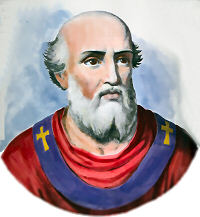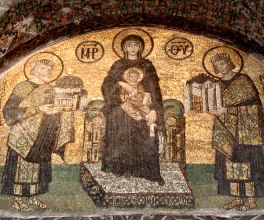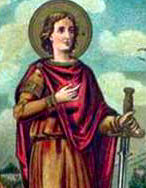
Daily Readings for: May 18, 2012
(Readings on USCCB website)
Collect: O God, who reward faithful souls and who have consecrated this day by the martyrdom of Pope Saint John the First, graciously hear the prayers of your people and grant that we, who venerate his merits, may imitate his constancy in the faith. Through our Lord Jesus Christ, your Son, who lives and reigns with you in the unity of the Holy Spirit, one God, for ever and ever.
- Regina Coeli (Queen of Heaven)
- Roman Ritual Blessing Before and After Meals: Easter Season (2nd Plan)
- Ascension and Pentecost Prayer Suggestions
- Prayer for Pope Benedict XVI
- Prayer Cards for Easter Grace at Meals
- Prayers for the Easter Season
- Prayers between Ascension and Pentecost
- Novena to the Holy Spirit
- Roman Ritual Blessing Before and After Meals: Easter (1st Plan)
- Novena to St. Rita
ACTIVITIES
PRAYERS
Easter: May 18th
Optional Memorial of St. John I, pope and martyr
Old Calendar: St. Venantius, martyr
John I was elected Pope in 523. The Arian King Theodoric sent him as his ambassador to Emperor Justin in Constantinople. On John I's return, he was captured by the king, who was displeased at the outcome of the embassy, and cast him into prison at Ravenna where he died a few days later. As pope he was responsible for introducing the Alexandrian computation of the date of Easter; it came to be accepted throughout the West.
According to the 1962 Missal of Bl. John XXIII the Extraordinary Form of the Roman Rite, today is the feast of St. Venantius, who was born at Camerino in Umbria, and was led at the age of fifteen before Antiochus, governor of the town under the Emperor Decius. He was made to suffer cruel torments, but angels came and assisted him. His tormentors were touched with repentance by his constancy and many were converted. He was beheaded around the year 250. His body lies at Camerino in the church dedicated to him. St. John I's feast in the Ordinary Form of the Roman Rite is celebrated on May 27.
St. John I
This Tuscan was destined to be glorified not only during his lifetime but after his death as well. Although peace with the East had been restored, a suspicious Theodoric grumbled in his castle at Ravenna. An Arian, the king saw the new friendliness between East and West as a serious threat to his reign. To further alarm him, Emperor Justin had reinstated the laws against heretics, Arians included, and had embarked on a campaign of confiscating churches and excluding heretics from public office, causing many Arians to abandon their faith. Infuriated, Theodoric summoned John to Ravenna and ordered him to head a delegation to the orthodox emperor to ask that the persecution stop and allow forced converts to return to Arianism. At first John refused, then fearing that the king's wrath would be taken out on Western Catholics, he agreed to do Theodoric's bidding on every count save one. He boldly told the king that he would not ask the emperor to allow converts to return to heresy.
The pope arrived in Constantinople shortly before Easter in 526, and since he was the first pope to leave Italy, his reception was more than he could have dreamed. He had been met by the entire city at the twelfth milestone, where the clergy led the procession carrying candles and crosses, and even the emperor prostrated himself before the Holy Father.  The day of Easter, John was seated in a throne higher than the one occupied by the patriarch, in the church of Sancta Sophia, where he celebrated Mass in the Latin tradition. John was accorded the highest honor when he placed the customary Easter crown on the head of Emperor Justin.
The day of Easter, John was seated in a throne higher than the one occupied by the patriarch, in the church of Sancta Sophia, where he celebrated Mass in the Latin tradition. John was accorded the highest honor when he placed the customary Easter crown on the head of Emperor Justin.
After meeting with Justin on Theodoric's behalf, the pope made the exhausting trip back to Ravenna. The king's fury raged. Jealous of the pope's grand reception in the East, Theodoric accused the pope of failing his mission by not securing all of the demands put to Justin. The king then ordered John to remain in Ravenna at his disposal. The aged pope was spent; the prospects before him were dismal. Already ailing, Pope John died and was hastily buried outside the castle walls. Pope John's body was exhumed and on May 27, 526, was returned to Rome and placed in the nave of St. Peter's.
— Excerpted from The Popes: A Papal History, J.V. Bartlett
Things to Do:
- The Church has had a long, unbroken line of popes. Have your children answer the following questions: How many popes has the Church had?; How many popes are honored with the title of saint, blessed or venerable?; Which pope reigned longest?; Which three names have been chosen most frequently by popes? You can check this page to help get the answers.
- Pray especially for the Holy Father today. Make sure your children know the Morning Offering in which we pray for the Holy Father's intentions.
St. Venantius When still a boy of fifteen, Venantius was martyred for his faith in his native city under the Emperor Decius (249-251). With heroic steadfastness he endured many and unspeakably cruel tortures. According to legend, he was scourged, burned with torches and hung headfirst over a smoking fire. He was then thrown to the lions; while they lay like lambs at his feet, he preached the Gospel to the people. This induced many pagans to accept the faith. Finally he was beheaded.
When still a boy of fifteen, Venantius was martyred for his faith in his native city under the Emperor Decius (249-251). With heroic steadfastness he endured many and unspeakably cruel tortures. According to legend, he was scourged, burned with torches and hung headfirst over a smoking fire. He was then thrown to the lions; while they lay like lambs at his feet, he preached the Gospel to the people. This induced many pagans to accept the faith. Finally he was beheaded.
— Excerpted from The Church's Year of Grace, Pius Parsch.
Patron: Camerino, Italy.
Symbols: Roman armour; banner; plan of Camerino; fountain.
Often portrayed as: Young man crucified upside-down with smoke coming from his head; young man holding the citadel of Camerino; young man holding the city of Camerino, a palm, and a book; young man with a banner holding a city wall.
Things to do:
- Today, let us renew our commitment to reading Scripture and take some time to mediate on a passage of the Gospel.